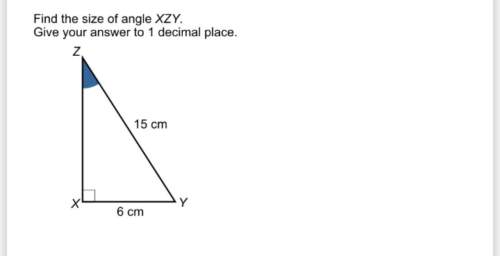
Mathematics, 16.07.2020 22:01 dxnimxriee
The law f(t) = -t2 + 6t + 15 represents the number of kilometers of congestion, as a function of time, registered in a city. With that, determine the maximum number of congestion in that city and the maximum time to reach this value.

Answers: 1


Another question on Mathematics


Mathematics, 21.06.2019 21:00
Mr.zimmerman invested $25,000 in an account that draws 1.4 interest, compouneded annually. what is the total value of the account after 15 years
Answers: 1

Mathematics, 21.06.2019 21:30
Awater truck is filling a swimming pool. the equation that represents this relationship is y=19.75x where y is the number of gallons of water in the pool and x is the number of minutes the truck has been filling the pool.
Answers: 1

Mathematics, 21.06.2019 22:30
Write the equation of a line that is perpendicular to the given line and that passes through the given point. –3x – 6y = 17; (6, 3) y = x – 9 y = 2x – 9 y = –2x – 9 y = x + 0 3. is the relationship shown by the data linear? if so, model the data with an equation. x y 1 5 5 10 9 15 13 20 the relationship is linear; y – 5 = (x – 1). the relationship is not linear. the relationship is linear; y – 5 = (x – 1). the relationship is linear; y – 1 = (x – 5). write an equation in point-slope form for the line through the given point with the given slope. (–10, –1); m = y + 10 = (x + 1) y – 1 = (x – 10) y – 1 = (x + 10) y + 1 = (x + 10) 5. write an equation for each translation of . 6.5 units up y + 6.5 = | x | y = | 6.5 x | y = | x | + 6.5 y = | x | – 6.5 6. write an equation for each translation of . 5.5 units right y = | x | + 5.5 y = | x – 5.5 | y = | x | – 5.5 y = | x + 5.5 | 7. which equation translates y = | x | by 8 units to the left? y = | x | – 8 y = | x | + 8 y = | x – 8| y = | x + 8|
Answers: 1
You know the right answer?
The law f(t) = -t2 + 6t + 15 represents the number of kilometers of congestion, as a function of tim...
Questions

Mathematics, 09.10.2019 14:50


Mathematics, 09.10.2019 14:50


Mathematics, 09.10.2019 14:50


Mathematics, 09.10.2019 14:50


Health, 09.10.2019 14:50

English, 09.10.2019 14:50


Social Studies, 09.10.2019 14:50

History, 09.10.2019 14:50


Social Studies, 09.10.2019 14:50


English, 09.10.2019 14:50







